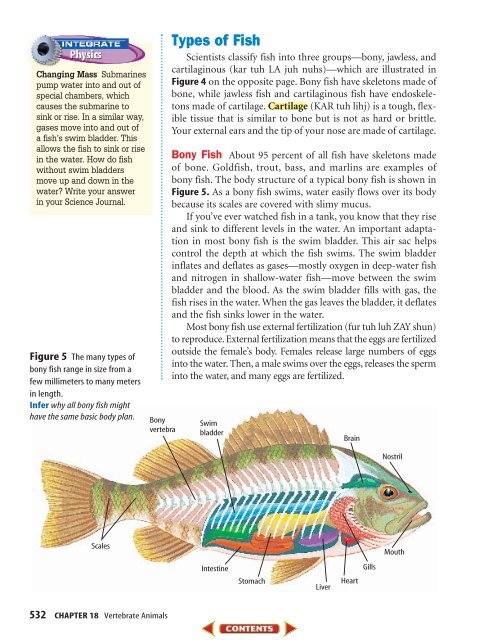Chapter 18: Vertebrate Animals
Chapter 18: Vertebrate Animals
Chapter 18: Vertebrate Animals
You also want an ePaper? Increase the reach of your titles
YUMPU automatically turns print PDFs into web optimized ePapers that Google loves.
Changing Mass Submarines<br />
pump water into and out of<br />
special chambers, which<br />
causes the submarine to<br />
sink or rise. In a similar way,<br />
gases move into and out of<br />
a fish’s swim bladder. This<br />
allows the fish to sink or rise<br />
in the water. How do fish<br />
without swim bladders<br />
move up and down in the<br />
water Write your answer<br />
in your Science Journal.<br />
Figure 5 The many types of<br />
bony fish range in size from a<br />
few millimeters to many meters<br />
in length.<br />
Infer why all bony fish might<br />
have the same basic body plan.<br />
Bony<br />
vertebra<br />
Types of Fish<br />
Scientists classify fish into three groups—bony, jawless, and<br />
cartilaginous (kar tuh LA juh nuhs)—which are illustrated in<br />
Figure 4 on the opposite page. Bony fish have skeletons made of<br />
bone, while jawless fish and cartilaginous fish have endoskeletons<br />
made of cartilage. Cartilage (KAR tuh lihj) is a tough, flexible<br />
tissue that is similar to bone but is not as hard or brittle.<br />
Your external ears and the tip of your nose are made of cartilage.<br />
Bony Fish About 95 percent of all fish have skeletons made<br />
of bone. Goldfish, trout, bass, and marlins are examples of<br />
bony fish. The body structure of a typical bony fish is shown in<br />
Figure 5. As a bony fish swims, water easily flows over its body<br />
because its scales are covered with slimy mucus.<br />
If you’ve ever watched fish in a tank, you know that they rise<br />
and sink to different levels in the water. An important adaptation<br />
in most bony fish is the swim bladder. This air sac helps<br />
control the depth at which the fish swims. The swim bladder<br />
inflates and deflates as gases—mostly oxygen in deep-water fish<br />
and nitrogen in shallow-water fish—move between the swim<br />
bladder and the blood. As the swim bladder fills with gas, the<br />
fish rises in the water. When the gas leaves the bladder, it deflates<br />
and the fish sinks lower in the water.<br />
Most bony fish use external fertilization (fur tuh luh ZAY shun)<br />
to reproduce. External fertilization means that the eggs are fertilized<br />
outside the female’s body. Females release large numbers of eggs<br />
into the water. Then, a male swims over the eggs, releases the sperm<br />
into the water, and many eggs are fertilized.<br />
Swim<br />
bladder<br />
Brain<br />
Nostril<br />
Scales<br />
Mouth<br />
Intestine<br />
Stomach<br />
Liver<br />
Heart<br />
Gills<br />
532 CHAPTER <strong>18</strong> <strong>Vertebrate</strong> <strong>Animals</strong>

















